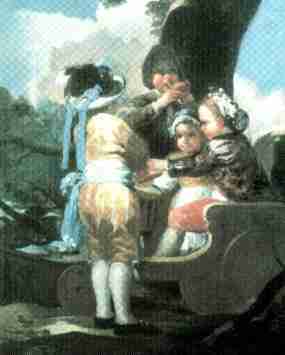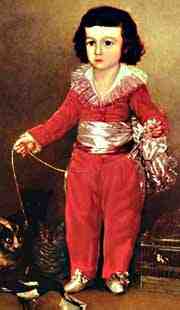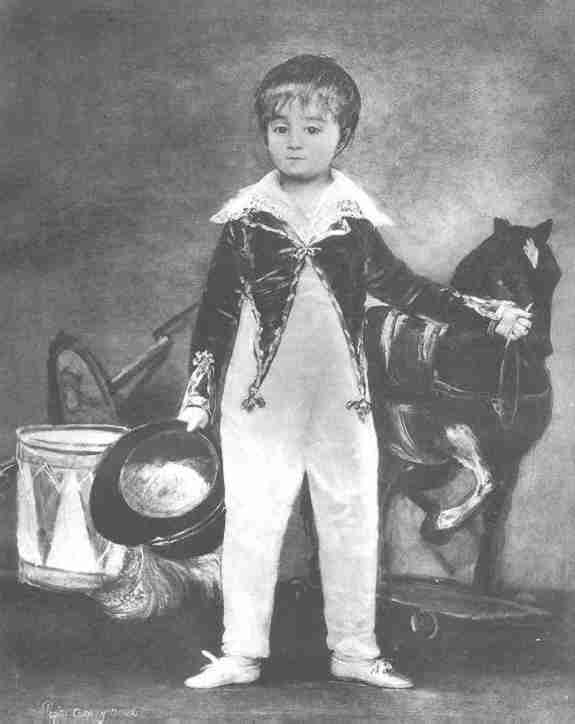
Artists Illustrating Boys' Fashions: Francisco Jose de Goya y
Lucientes, (Spain, 1746-1828)

Figure 1.--Goya painted these children in a cart during 1778. It was a "cartoon" whic served as a model for a royal tapestry--the first of many such official commissions. Notice the bright yellow color of the skeleton suit. Note the extensive use of ribbons, on the hat, sash, and to fasten the hem of the knee breeches. Note that these "cartoons" could not be detailed and every detail complicated the weaving.
|
Goya along with El Greco and Velasquez is one of the three great pillars of classical Spanish art, to which Picasso has to be added in our modern era. Between the death of Velasquez in 1660 and the thunder bolt of Picasso's Guernica, it was Goya who dominated Spanish art. Goya addressed many different genres and styles. His paintings range from realistic views of beautifully dressed personages at the Spanish court to the horific dark images of the Napoleonic Wars. He was the court painter to Charles IV. He is widely known for his portraits of Spanish nobility, including boys, but he also painted many accomplished scenes of peasants and ordinary street life. His paintings provide many insights of how boys dressed in the late 18th and early 19th Centuries--the point at which specialized children's clothes were emerging in Europe.
Background
Goya was born into a Spain undergoing deep-seated changes. The Spain of his birth
was a decaying world empire that had become after the turn of the century a
Napoleonic fiefdom. He lived to see a reborn kingdom struggling, with difficulty,
to become a modern European state. Parallel changes were afeecting the world
of European art. The pastel frivolities of the Rococo with the heroic severity of
Neoclassicism.
Parents
Goya's parents were José Goya and Engracia Lucientes. His father was a master guilder which provided the young Francisco a entry into the world of art.
Childhood
Francisco Jose de Goya y Lucientes was born on March 30, 1746, in the small
rural village of Fuendetodos, in the northeastern Spanish province of Aragon. The family moved to nearby Zaragoza when Francisco was 4 years old. We have virtually no information about his childhood or how he was dressed as a boy. His father's occupation as a guilder meant that Francisco would have known many artists and have had an opportunity to observe them painting. There are no real records of his childhood. A friar is reported to have observed Francisci drawing a pig on a wall and suugested to his father that the boy should take art lessons. At the age of 14, Francisco was appreticed to a painter in Zaragosa with a reputation for teaching skills. [Meisler, p. 49.]

Figure 2.--Aristocratic families throughout Europe showed considerable
similarities in their fashion. This aristocratic Spanish boy was
painted by Goya about 1790. Note the suit now has long pantaloons
which would not have been worn by his father.
|
Education
He went to a religious school called the Escuelas Pias de San Anton. After completing his apreticeship, the ambitious young man left home at 17 years of age in 1763 to seek his. He studied for a time in Rome.
Marriage
Goya won some commissions as a young artist which established him well enough to marry. He married married María Josefa Bayeu in 1773. Goya's wife had a brother who was at artist at the royal court--Francisco Bayeu. This entry later in his life helped him out by taking him into the royal home and recommending him. We know little about María Josefa. Goya rarely mentioned her in his correspondence. She died in 1812,
Children
Giya's wife María Josefa had six children. There were also several muscairriages which affected her health. Only Francisco Javier Pedro born in 1784 survived childhood. Javier also painted, but his work has none of the power of his father.
Duchess of Alba
Goya was married to Josefa Goya, but in 1784 began an affair when his wife wasn't around. He was turning to the Duchess of Alba for emotional support, which in those days was considered a beauty. The duchess was married to the Marquis of Villafranca. Goya and the duchess became lovers. Details on the their relationship still remains a mystery. One novelist desribed at temptuous relationship. [Feuchtwanger] There is little real information to confirm this. The duchess died in 1802.
Martin Zapater
Goya's lifelong friend, Martin Zapater, died in 1803. Zapater was a beloved
friend. He wrote letters, confiding many things about his life including his relationship with the Duchess of Alba. Much of what we know about Goya comes from those letters.
Career
Goya began his artistic life in 1774 by creating designs (called cartoons) that were used as tapestries for royal homes. About a year later in October 30, 1775 Goya made 9 cartoons, or tapestries, for King Charles III and the originality of these paintings drew the court's attention. These paintings and drawings were lucrative, but not prestigious. Goya by 1776 was getting paid an annual salary paid by his royal patrons.
Goya attempted many times to obtain an appointment as court painter but was
always rejected. Anton Mengs (the court painter) died on June 29, 1779. Afterwards Goya applied for the position but was again rejected. Instead they chose another painter, Mariano Salvador Maella. Goya decided to apply for another position in July 1780. He was elected to the Royal Academy of San Fernando, the most important Art Academy of Spain. He came to
became the assistant director of painting there in 1785.
Prince Charles chose Goya to decorate the new Church of San Francisco el Grande and
seven others in 1781. He also won the commission to paint the largest of the
church's altar pieces. Goya and his wife then moved in with the royal family in
August and September 1783. Goya became one of the close friends of the King
Cgarles (Carlos) III and as he lived with the royal family he was treated as a prince. He had everything. As a going-away gift the family gave him a silver and gold gown for his wife worth 30,000 reales. Another source suggests that Goya was closer to Charles IV. [Meisler, p. 49]
Goya became seriously ill for the first time in 1777. Then in 1792 his
second illness became far more serious, and he spent many months recovering at a
friend's house, Sebastian Martinez's home in Cadiz. He suffered from noises in
his head, loss of balance, loss of vision, delirium, and paralysis. After this, Goya became
permanently deaf. Although all these things happened, they didn't seem to
impair his creativity, in fact, they seemed to encourage to continue
painting. It did, however, curtail the joy he took in hobnobbing with his
aristocratic friends.
The prime minister Luis de Urquijo honored Goya on October 31, 1799, with
the highest position a Spanish artist could achieve, first court painter.
That was when he became the most important painter in the nation. While he
had this position in the early 1800s he painted the family of King Carlos IV.
He stayed at court during the reigns of Carlos III, Carlos IV, Joseph Bonaparte, and Fernando VII, showing amazing political adroitness. Eventually the enemies he made forced him to emigrate to France (Bordeaux) where he continued to work prolifically for the last 5 years of his life.

Figure 3.--This lithograph of a Goya drawing shows a Spanish boy wearing a skeleton suit. His jacket, however, is quite different than mos skeleton suits. I'm not sure who the boy is or when he was drawn.
|
The Peninsular Campaign was the most potracted conflict of the Napoleonic Wars. The French defeated the Sapnish Army early in the War. The struggle was continued by the British under Wellington and Spanish irregulars. The term "gurellas" was coined during the Peninsular Campaign. The War degenerated into one of the most brutal and horific conflicts of the Napoleonic era. Goya captured the darker side of mankind in his dark, brooding images of the Peninsular Campaign. There was no attempt to glorify war as was the normal practice in European painting. They were also not the detailed realistic images of his earlier paintings. French novelist André Malraux maintains that "modern art begins" with Goya. Many artists painted scenes from the Napoleonic era, normally expansive panoramic scenes of major battles. Goya's brooding images of war stand in sharp contrast to David's
heroic French images. It was Goya who truly captured the ferocity of the War. One art hitorian writes, "The only major artist who ... made some kind of aesthetic sense of the long wars was Francisco Goya ...." [Johnson, p. 461.]
Body of Work
Despite a career that extended over half a century, Goya is most admired today for
the satirical, melancholic, and sometimes even horrific canvasses of his later years.
He is also known for his subversive humor of his prints (such as the
Caprichos, 1799, and Disasters of War, circa 1810); the unalloyed
frankness of his, Portrait of the Family of King Carlos IV (1800); and the dramatic realism of his Third of May 1808 (1814). The nightmarish imagery of the bitter "black paintings", such as Saturn Eating His Children (circa 1821), testifies to the value placed on the sublime and the terrible that heralded the age of Romanticism. Some of argued that the realistic renderings, in many instances unflatering, was a kind of cocial criticism of the aristocrcy. This seems rather unlikely. Apparently his honest realism pleased his patrons. Goya worked very hard to achieve his position as a court painter and it difficult to believe that he would have jepordized this appointment by using his portraits to criticize his patrons, according to art curator and Goya specialist Janis Tomlinson. [Meisler, p. 50]
Spanish Art
Spain produced two true artistic geniuses (El Greco and Velasquez) in the 16th and 17th centuries, but with the exception of Goya there is a lack of notable artistic expression in the 18th and 19th centuries until Picasso appears in the 20th century. Notably both Goya and Picasso had to leave Spain. One art historian writes that Goya "suddenly emerged from a Spain everyone thought artistically dead and then just as suddenly departed, shutting the doors behind him." [Johnson, p. 461.] One wonders why great art disappeared in Spain over such an extended period. Certainly the declining economy was a factor. One is drawn to the lingering effect of Spanish Inquisition which made innovation and inspiration dangerous matter. Spain which before tghe expulsion of the Jews and Moors had been noted for its openness and toleration became one of the most closed societies in Europe. Spaniards came to fear foreigners and foreign innovations. This closure to foreign ideas also meant the ideas of political and economic change. While aimed initially at religious deviation, there were ripple affects throughout Spanish society and culture. The most fierce years of the Inquisition were in the 15th-17th centuries, but the mindset created by the Inquisition was firmly established by the 18th century.
Fashions Depicted
He is widely known for his portraits of Spanish nobility. They display remarkable psychological acumen and a broad and bold use of painting technique. Goya slowly developed in his art a powerful sense of social satire which was first manifest in his paintings of Spanish royalty. These paintings included the younger royals and aristocrats. His paintings thus provide many insights of how wealthy, titled boys dressed in the late 18th and early 19th Centuries--the point at which specialized children's clothes were emerging in Europe. He pointed both Spanish and French arisocrats. These portaits give no clue as to his political sympathies. One of these portaits is that of Victor Guye, the son of one of the most important French generals in Spain. Goya's images are some of the earliest images of the developing fashion of specialized children's clothes. Many of the boys' wear luxurious skeleton suits. Goya did not only paint the nobility. He also painted many accomplished scenes of peasants and ordinary street life. These images show how working-class and peasant boys dresses, in short contrast to his portraits of the nobility.
Sources
Feuchtwanger, Lion. This is the Hour (1951). This is a novel, not a documented historical study, but is a fascinating read.
Meisler, Stanley. "Goya & his women" Smithsonian April 2002, pp. 46-54.
Johnson, Paul. Art: A New History (Harper Collins: New York, 2003), 777p.
HBC

Navigate the Boys' Historical Clothing Artist pages:
[Return to the Main Spanish artist page]
[Return to the Main artist page]
[Chronology]
[Countries]
[Individuals]
[Styles]
Navigate the Boys' Historical Clothing Web Site:
[Introduction]
[Activities]
[Biographies]
[Chronology]
[Clothing styles]
[Countries]
[Topics]
[Bibliographies]
[Contributions]
[FAQs]
[Glossaries]
[Satellite sites]
[Tools]
[Boys' Clothing Home]
Created: June 22, 1999
Spell checked: July 30, 1999
Last updated: 4:24 AM 7/6/2004





